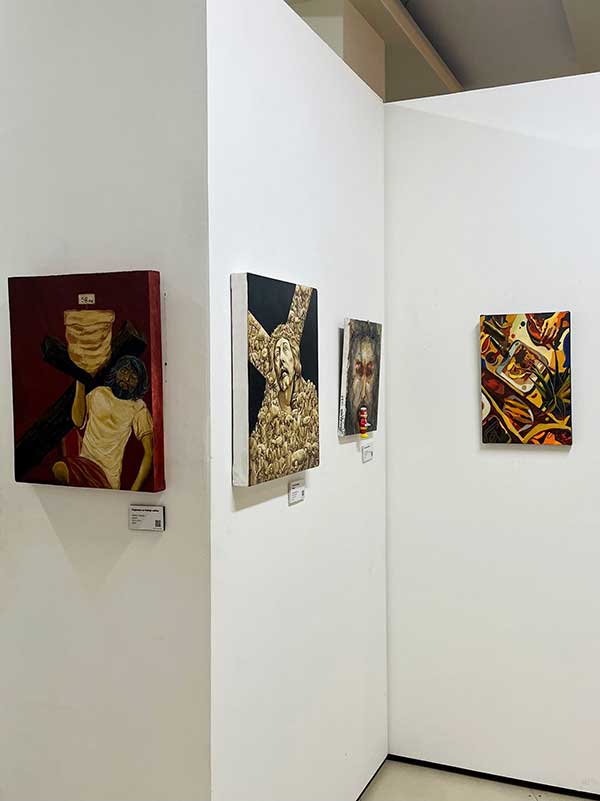By John Anthony S. Estolloso
WHILE THE figure of the Christ is central to religious iconography, the variations of the crucified persona cannot readily isolate itself from the capricious – and sometimes clashing – contexts that cultural influences and interpretations provide. Seen solely from this semiotically narratological point of view, the history of Christianity could have been reduced to a plethora of crosses and crucifixes, so designed as the times à la mode would have wanted it.
So, in a Calvary full of crosses and crucified figures, which Christ are we looking for?
Thrive Art Gallery’s iteration of ‘Kristo: Christ and Culture’ unveils a glimpse of this search for a viable imago Dei, one that captures what local sensibilities would have wanted to see. In essence, the exhibit captures the core of Christianity, taking on its subject the central figure of the faith, yet simultaneously insisting upon an Ilonggo lens that makes what is seen relatable and at certain moments, snidely empathetic to the Filipino experience.
Granted, there are classical allusions rendered almost as hommages to the canonical masters. Art Geroche’s scenes from the scriptures would have readily found their way as elements for the Stations of the Cross of any hoary church or cathedral. Cezar Arro’s close-up portrait of Christ in monochromatic hues is distinctly modernist, yet the figure distinctively evokes a homely familiarity of the persona. And who can escape the pathos of Kristoffer Brasileño’s Madonna, almost as tender as the Pieta of old?
While these conjure traditional imagery usually associated with religious art, there are others that would seek to recreate the conventional to more contemporary tastes. Transcending the kind of Christianity – the zealously occidental Bible-thumping type – that influenced our culture and lifestyle, the artworks conversely insist that our mores and their contemporary nuances and issues impose themselves on Christ and how the persona is seen and understood through the eyes of the local art scene. In all aesthetic appearances, the religious has become the social and the political.
Take for instance how PG Zoluaga’s INDI [a play on the Latin initials inscribed on most crucifixes] superimposes a barong on the figure of Christ with mouth agape in a silent scream. On the four corners of the cruciform are factory labels, a not-so-subtle hint of our neocolonial love-hate relationship with former colonizers, even as we get crucified by the rigmarole of playing martyr.
At another corner, Jzy Tilos’s Sakripisyo, a massive lump of concrete sculpted to the face of the agonizing Christ, is crowned with circlets of barbed wire: an elusive hint to when it first made its appearance at the barricades of EDSA in 1986, amidst a sea of yellow ribbons and shirts?
And as if to comment on the daily proletariat struggle, Richard dela Cruz’s Kanya-kanyang Pasan directly incorporates scenes of laborers carrying sacks of grains into the persona of Christ bearing the cross: for once, the overworked peasant is one with the condemned fisher of men.
Aubrey Carnaje’s gun-tied rosary speaks much of national woes even as Munding Salao’s caricaturesque Longinus retains soldierly vigor in the spear-thrust that drew blood: devoid of the comic, they still scream bloody murder. Carlo Juntado’s surreal juxtapositions of the sacred and profane put to test the sensibilities between the religious and the artistic: in this conflicted frame, here meets Basquiat, Dali, and Fra Angelico.
Yet while taking a step back from the imges that meets the eye, the viewer also comes to terms with the maleness of it all: it is a display of predominantly male artists, with canvases and assemblages inundated with traditional male archetypes, and altogether, an overflowing of imagery associated with the maintenance of a fragile, double-standard Filipino patriarchy.
There are more of these in the exhibit and while the frames and installations portray Christ from activist to anachronism, from peasant to priest, they exude his Everyman-ness – like us before, today, and tomorrow.
*****
The Christian community has now entered the days of Semana Santa and while people from the pulpits will exhort us to reflect on Christ’s passion and death, we might just as well look at the sorrow and the suffering on the canvas and in the frame.
But whose sorrows and sufferings are these truly? We can argue with all the theology and doctrine we can muster – but would Christ in the canvas really care?
(The writer is the subject area coordinator for Social Studies in one of the private schools of the city. The photos are from the FB page of Shops at Atria and are used with permission.]























